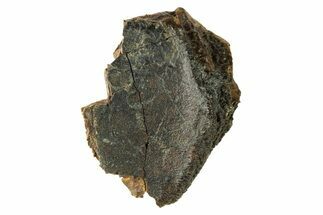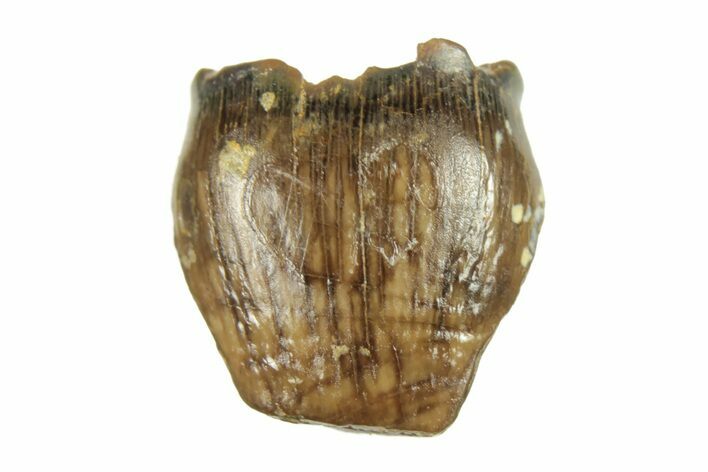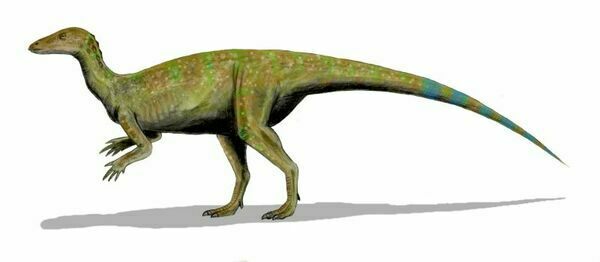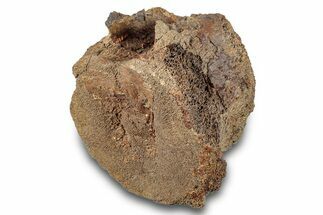This Specimen has been sold.
.17" Cretaceous Dinosaur (Thescelosaurus) Tooth - Wyoming
This is a .17" long tooth of the neornithischian dinosaur, Thescelosaurus neglectus. It was collected from the Late Cretaceous-aged Lance Formation in Wyoming.
Comes with an acrylic display case.
Comes with an acrylic display case.
Thescelosaurus was a small ornithopod dinosaur that appeared at the very end of the Late Cretaceous period in North America. Many specimens' preservation and completeness indicate that Thescelosaurus may have preferred to live near streams.
This bipedal ornithopod is known from several partial skeletons and skulls, all of which indicate adult lengths between 2.5 and 4.0 meters (8.2 to 13.1 feet) on average. It had sturdy hind limbs, small wide hands, and a head with an elongated pointed snout. Their teeth and jaw morphologies suggest a primarily herbivorous diet.
This bipedal ornithopod is known from several partial skeletons and skulls, all of which indicate adult lengths between 2.5 and 4.0 meters (8.2 to 13.1 feet) on average. It had sturdy hind limbs, small wide hands, and a head with an elongated pointed snout. Their teeth and jaw morphologies suggest a primarily herbivorous diet.
The Lance Formation of Wyoming, which dates back to the Late Cretaceous period between 66 and 69 million years ago, is home to a wide variety of both dinosaur and assorted small vertebrate fossils. During the Cretaceous, this midwestern formation would have been comprised of streams connected to the large Western Interior Seaway that split continental North America in half down the midwest. As a result of the subtropical climate and frequent rainfall, life flourished both on land and in the sea. These wet environments created perfect scenarios for sediment deposition, making the resulting Lance Formation such a fertile fossil site.
Perhaps the most famous Lance resident would be Tyrannosaurus rex, the largest North American carnivore to ever live. However, other smaller theropods also roamed the American midwest in this subtropical coastal stream system, including the beaked Ornithomimus, a lanky running theropod with a build similar to a modern ostrich, as well as several small predatory troodonts such as Paronychodon and Pectinodon.
Herbivorous dinosaurs also took advantage of the abundance offered by this unique era. Armored ankylosaurs dwelt in herds, their safety assured by their numbers, their heavy bone plating protecting most of their bodies and even their eyelids, and huge bone clubs on the ends of their tails providing them with powerful offensive capabilities. Ceratopsians like the famous Triceratops also formed protective herds, guarding their necks with frills and horns. Their smaller relatives, the dome-headed pachycephalosaurs, were also well represented in the area. Hadrosaurs, duck-billed titans with huge batteries of plant-grinding teeth in elongated snouts, are also well known from the region.
In addition to dinosaurs, a wide variety of fishes, amphibians, lizards, snakes, turtles, champsosaurs, crocodilians, and pterosaurs have been found in the formation.
Perhaps the most famous Lance resident would be Tyrannosaurus rex, the largest North American carnivore to ever live. However, other smaller theropods also roamed the American midwest in this subtropical coastal stream system, including the beaked Ornithomimus, a lanky running theropod with a build similar to a modern ostrich, as well as several small predatory troodonts such as Paronychodon and Pectinodon.
Herbivorous dinosaurs also took advantage of the abundance offered by this unique era. Armored ankylosaurs dwelt in herds, their safety assured by their numbers, their heavy bone plating protecting most of their bodies and even their eyelids, and huge bone clubs on the ends of their tails providing them with powerful offensive capabilities. Ceratopsians like the famous Triceratops also formed protective herds, guarding their necks with frills and horns. Their smaller relatives, the dome-headed pachycephalosaurs, were also well represented in the area. Hadrosaurs, duck-billed titans with huge batteries of plant-grinding teeth in elongated snouts, are also well known from the region.
In addition to dinosaurs, a wide variety of fishes, amphibians, lizards, snakes, turtles, champsosaurs, crocodilians, and pterosaurs have been found in the formation.
SPECIES
Thescelosaurus neglectus
LOCATION
Wyoming
FORMATION
Lance (Creek) Formation
SIZE
.17" long
CATEGORY
SUB CATEGORY
ITEM
#265803
We guarantee the authenticity of all of our
specimens. Read more about our
Authenticity Guarantee.
specimens. Read more about our
Authenticity Guarantee.
 Reviews
Reviews












